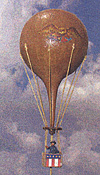
Appendix E of the original "Johnny Reb" rules makes provision for use of balloons, with the following limited rules:
1 . From where the balloon is located, the observer is assumed to have an unobstructed line of sight of 360° to a distance of three feet at early morning and late evening, and of five feet at mid-day.
(15mm miniature balloon sold by Larry Reber)
2. For every enemy hidden movement marker within the determined radius, roll one die. If the number from the following table is rolled, then the opposing side must report whether the hidden movement marker is real or dummy. No other information need be given.
Marker in open: roll 1, 2, 3, 4 Marker in light woods: roll 1, 2 Marker in heavy woods: roll 1
For visibility purposes, the presence of buildings, fences, forts, or other obstructions are ignored, but the woods are still counted as concealment.
The "playability" of the balloon is enhanced, however, by modifying and adding the following house rules. These enhancements simulate the arguably limited utility of an observation balloon, while permitting the balloon to confer some benefit to the player wily enough to exploit such newfangled technology.
3. At the beginning of each turn, the player with the balloon may select one - and only one - enemy unit marker to "observe." If the roll is successful, the real or dummy nature of the selected marker must be revealed per the Johnny Reb rules (except that counters in the open should betevealed on a roll of 1-5, not 1-4 as in rule 1), as well as the type of unit the counter represents (i.e., cavalry, infantry, or artillery). The observation roll is made at the very beginning of each turn, but such a roll can only be attempted if the casting representing the overall commander of the forces owning the balloon is within one inch of the ground crew (see below) at the beginning of the turn.
4. Use one stand of three or four infantry castings to represent the "ground crew" of the balloon. The crew administers the balloon's mooring, gas apparatus, and telegraph, and can be located anywhere within the circular base of the balloon's stand. The mixed soldiers and civilians of the ground crew move at the disordered rate for the applicable terrain at all times, unless routed. The ground crew checks morale like a single section of artillery, and may be "supported" by batteries, infantry, or both. They take saving rolls [JR1 and 2] and hits like an unlimbered artillery crew, except that "kills" need not be inflicted in multiples of two. [For JR3, simply use the unlimbered artillery modifiers and rules]. Melee rules for artillery crews apply.
5. The ground crew may be wiped out, routed, or may voluntarily exit the circular base of the balloon. If the ground crew leaves the circle of the base, however, no observation rolls may be made until the beginning of the turn after the crew returns.
6. If both friendly and enemy units occupy the circle of the base at the beginning of a turn, no observation roll can be made. If only units of one side occupy the circle, the balloon may be "released" (that is, its moorings are cut). The ground crew or unit releasing the balloon must place a "HOLD" order and the player must announce the intent to release; any fire by the unit that turn is halved. If the balloon is released, it is removed from play for the remainder of the game.
7. Moored Civil War-era balloons were not terribly mobile. The balloon may only be moved by its ground crew, which places a "HOLD" order for the equivalent of eight fifteen-minute game turns [JR1 and 2; for JR3, this is reduced to six twenty-minute turns]. The balloon is being "reeled in," packed up and stowed, and during which observation rolls are not possible [it is presumed that the telegraph lines are inoperable during the descent]. The ground crew then moves and takes hits with the stowed balloon like limbered artillery [use a covered wagon to simulate the moving unit]. An additional eight [JRI and 2] turns without observation are required to deploy the balloon upon its arrival at a new location. The moral: deploy the balloon wisely in the first place!
8. Balloons frequently were fired upon. Because they were commonly deployed at a height beyond the effective range of rifled muskets, these rules presuppose that only artillery may effectively fire at a deployed balloon. Because elevation of the guns was a problem, the crew of any section or battery intending to fire on a balloon must first spend one full turn bracing logs and rocks under the gun's wheels, using the procedure for hasty works. Thereafter, if the gun is within thirty inches (measured from the muzzle to the basket), it fires by rolling two dice with no modifiers. A roll of a 2 is a hit for smoothbores; a roll of 2 or 3 is a hit for rifled guns. A single hit immediately destroyed the balloon, and the ground crew is removed.
Article reprinted by permission from The Zouave, Vol. 4, Issue 2, with modifications by Scott Mingus
Back to Table of Contents -- Charge! # 5
Back to Charge! List of Issues
Back to MagWeb Master Magazine List
© Copyright 2004 by Scott Mingus.
This article appears in MagWeb.com (Magazine Web) on the Internet World Wide Web.
Other articles from military history and related magazines are available at http://www.magweb.com